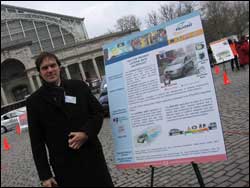Automotive Engineering highlights issues related to automobile manufacturing – including vehicle parts and accessories – and the environmental impact and safety of automotive products, production facilities and manufacturing processes.
innovations-report offers stimulating reports and articles on a variety of topics ranging from automobile fuel cells, hybrid technologies, energy saving vehicles and carbon particle filters to engine and brake technologies, driving safety and assistance systems.

Particulate emissions from diesel engines are currently measured by smoke darkness in motor vehicle inspections. This method is particularly unsuitable for measurement of the smallest particles, which are considered as being the most dangerous. There are over 100,000 vehicle inspection stations in Europe using smoke darkness to measure particulate emissions.
The authorities have noticed the shortcomings in measuring diesel smoke in this way and have been fervently seeking new met

For Europe’s 300 million drivers and other vulnerable road users, new Information and Communication Technologies-based technology cannot come fast enough. Concerted effort from researchers aims to fast track intelligent-car technology for improved road safety to ultimately save lives.
Although safety is improving on European roads, every year over 40,000 people die on Europe’s roads and 1.4 million accidents occur. Clearly, there is still plenty of work to be done if the EU is to

Highways of tomorrow might be filled with lighter, cleaner and more fuel-efficient automobiles made in part from recycled plastics, lignin from wood pulp and cellulose.
First, however, researchers at the Department of Energy’s Oak Ridge National Laboratory, working as part of a consortium with Ford, General Motors and DaimlerChrysler, must figure out how to lower the cost of carbon fiber composites. If they are successful in developing high-volume renewable sources of c

The U.S. Department of Energy’s National Renewable Energy Laboratory (NREL) has demonstrated that ventilated automotive seats not only can improve passenger comfort but also a vehicle’s fuel economy. That’s because ventilated seats keep drivers and passengers cooler, so they need less air conditioning to be comfortable.
NREL’s Vehicle Ancillary Loads Reduction team has been working with industry to try to reduce fuel consumption from air conditioning in cars and

Every year in the European Union there are over 9,000 deaths and 200,000 injured victims in road accidents in which pedestrians and cyclists collide with a car. Hoping to improve on these grim statistics, is a cutting-edge sensing system that could ultimately help to save the lives of vulnerable road users (VRUs).
“The concept is relatively straightforward,” explains Dr Marc-Michael Meinecke of Volkswagen, one of the chief partners in the SAVE-U project along with DaimlerChrysle

Researchers at the National Institute of Standards and Technology (NIST) are assisting the Department of Transportation (DOT) by developing tests for a crash avoidance system that could substantially reduce the number of rear-end, road departure and lane change accidents. About 1,836,000 such accidents occur annually, or 48 percent of police-reported cases a year.
DOT’s “Integrated Vehicle-Based Safety System” (IVBSS) for light vehicles and trucks is a single crash avoidance system u